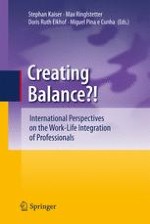2011 | OriginalPaper | Chapter
7. Work-Family Balance, Role Integration and Employee Well-Being
Authors : Ann Chunyan Peng, Remus Ilies, Nikos Dimotakis
Published in: Creating Balance?
Publisher: Springer Berlin Heidelberg
Activate our intelligent search to find suitable subject content or patents.
Select sections of text to find matching patents with Artificial Intelligence. powered by
Select sections of text to find additional relevant content using AI-assisted search. powered by
